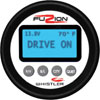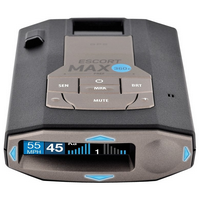I have received more detailed information on the new 2006 Whistler models. They have some very interesting models coming out, with some features that are truly new to the radar detector world.
All of the 2006 models are part of a new series, called the "XTR Series". This XTR series seems to break down into two sets of detectors. For lack of a better name, I'll call them the "Changeable Trim Models" and the "Remote Control Models".
One thing that seems to be common to all XTR models is a different type of text display. All of the models with an alpha-numeric text display have the same blue-back-lit display of the Whistler 1788 cordless detector. Prior to the 1788, Whistler detectors had always had red or blue text on a black background.
While there is no definite release date, we are hoping to have these models in stock in April.
Changeable Trim Models
The XTR-325, XTR-425, and XTR-560 detectors make up the set that I'm calling the "Changeable Trim Models". These models are all shaped similar to previous higher end Whistler detectors such as the Pro 73, but they have added a plastic trim ring to the top of the detector. The trim ring can be switched out with different colored rings. Three rings are included with each model.
All of these models will detect the Ku band. Whistler doesn't believe that the Ku band will be a threat in the US in the near future, so they are not planning to promote the Ku feature. By default, detection of the Ku band will enabled in these models, however it is user selectable and can be disabled.
All of these models are compatible with the programmable Intelli-Cord.
Two of these models offer programmable alerts. The XTR-425 has a programmable text display, which means you can change the text CITY or HIGHWAY (or a few others) to say anything you want, within certain limitations (8 characters or less). The XTR-560 also has programmable audio alerts. This will let you record your own alert tones and assign it to any band, replacing the internal alerts.
Here's a little more about each model:
The XTR-325 has voice alerts, an icon display with numeric signal strength indicator, and includes red, blue, and gold trim rings. MSRP is $129.95. Our site will probably have it initially priced at $89.99.
The XTR-425 also has voice alerts, but adds a programmable text display. White, silver, and red trim rings are included. MSRP is $139.95. Our initial price will likely be $99.99.
The XTR-560 is the top of the line XTR model, adding programmable voice alerts to the programmable text display. The included trim rings are black, blue, and pink. MSRP is $199.95 but we will probably have it for $139.99.
Remote Control Models
The XTR-220 and the XTR-520 are targeted at customers driving vehicles with a hard-to-reach windshield. Instead of stretching to reach the detector, they can control all of the major functions from a key chain remote. With no buttons on top of the detector, these two detectors have a look different from previous Whistler models.
These models will not detect the Ku band, nor will they be compatible with the Intelli-Cord. At this time, no other models will be "remote compatible".
The XTR-220 has an icon display with numeric signal strength indicator. MSRP is $119.95. Our site will probably have it initially priced at $79.99.
The XTR-520 adds voice alerts and a text display. MSRP is $159.95, but our price will likely start at $109.99.
 | |  | |  | |
| XTR-220 | | XTR-520 | | XTR Remote | |
FuZion Installed Detector
The new FuZion radar detector is basically a Whistler Cruisader that is made for regular vehicles. Like the Cruisader, the FuZion will fit in a standard 2 1/16 gauge or pillar enclosure. People love this about the Cruisader, so it should be a big hit with the FuZion. The FuZion will not detect the Ku band.
 | |
| FuZion | |
That's all for now, but I will provide more information on these new models when I receive it!










